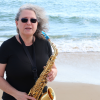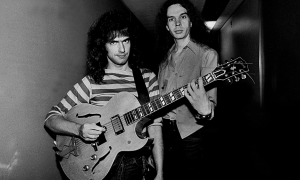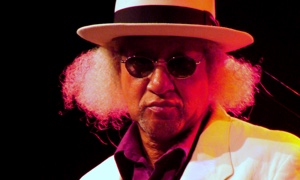Home » Jazz Articles » Jazz Ed » Steve Roach from California State University in Sacramento
Steve Roach from California State University in Sacramento

Even though the world is a fickle place for creative artists, music is bigger than that. I say you have to go for it.
—Dr. Steve Roach, Director of Jazz Studies at CSUS
Steve is the co-founder of the Sacramento Jazz Orchestra, performs in university musicals, reproduced the Beatles' White Album as a fundraiser, and is an active member of the 4 Thought Trio.
At CSUS there are 13 jazz ensembles: two big bands; a Latin jazz band; four vocal jazz groups and six combos. The university serves as home base to the Sacramento Jazz Orchestra, which is made up of regional educators, and it hosts a popular winter high school jazz festival which attracts a lot of notice. According to CSUS professor and saxophonist Mike McMullen, the program is regarded in the top three in the California State University system.
All About Jazz: When did the jazz program start?
Steve Roach: In 2003, and it was the result of the university offering a full-time position in jazz studies in 2001. I was fortunate to get that job offer. The first two years here I implemented the necessary new course proposals for the new degree and chaired the committee for the hiring of new faculty members.
AAJ: There are students who automatically want to join the jazz band because they love jazz. How do you open the minds of other CSUS students who have not yet discovered jazz?
SR: I have students regardless of their major: non-music and music ed majors. I welcome any of them to audition. Education students may be shy but they need to be well-rounded educators.
AAJ: Do you invite guest players?
SR: Many! Each year we have from two to three different guest artists or small groups. Past guest artists include Donny McCaslin, Wycliffe Gordon, The New York Voices, Terell Stafford, Ernie Watts, John Fedchock, and many others. I get a lot of inquiries and I could easily host several more throughout the year if it weren't for my limited budget.
AAJ: Have you had pros teach a workshop?
SR: In December [2017] we'll have The New York Voices on campus to work with our vocal jazz ensembles, and we have options to bring in other artists. I try to book 6-12 months in advance. Our budget is limited for scholarships and guest artists, so it's amazing what we're able to accomplish. We go on tour and to festivals too.
AAJ: How do you deal with "too many" of a certain instrument who want to join an ensemble?
SR: We are open for doubling, because I want everybody included.
AAJ: Does being a trumpet player specifically inform your teaching style and content?
SR: I think it does. We teach the way we have experienced music ourselves. It benefits me melodically and stylistically. The trumpets are usually on melody and they guide the dynamics and the style of the music. Especially when we're doing swing style; you can't swing unless the articulation is correct.
AAJ: What periods in jazz are studied in the program?
SR: I have a foot in the past and a foot in the present. The essence of big band music is swing. Ragtime not so much. I start in 1930s. It's important to teach swing concepts. But I'm a huge fan of contemporary music such as Maria Schneider, The Gotham Jazz Orchestra, Florian Ross, James Miley, Jim McNeely, Bob Brookmeyer, Kenny Wheeler and many fabulous European ensembles.
AAJ: Do you discuss employability with the students—the difficulty in sustaining oneself for a chosen career?
SR: It's a constant topic when I advise students, and a huge part of my job. I thought it was going to be "let's fall in love with music." It's a very important concern for a lot of students: "How am I going to make a living at it?" I've come up with my own philosophical statements on that. If you are doing something you're so passionate about and deeply in love with, you will make it work. There is no plan B. I believe in that process. Even though the world is a fickle place for creative artists, music is bigger than that. I say you have to go for it. Employment will work itself out. I'm straight with them that the most practical degree plan is music ed. Our placement is almost 100%. They're placed almost immediately in California.
AAJ: How many students would you say are seriously interested in a career in jazz?
SR: Our jazz program has 30-60 students and they are all definitely interested in jazz as a career.
AAJ: Is the program at CSUS growing?
SR: It has held steady, but it definitely fluctuates. The quality has been maintained. There are 23 California State universities so students have lots of schools to choose from. We stay active in performing at regional jazz festivals such as The Monterey Next Generation Jazz Festival and The Reno Jazz Festival. We also maintain a steady schedule of recording the ensemble. We want to keep our name out there.
AAJ: Do you have additional comments about the future of our younger generations embracing jazz?
SR: I think one of drawbacks is the new generation doesn't buy CD's, they stream everything and as a result, often times they don't know who the personnel are. They don't know who was the pianist, bassist or when it was recorded. They might be exposed to it, but don't know that basic information. However, I'm constantly amazed at the students' playing ability! The passion is just driving. Millennials are embracing social media like YouTube and they can record themselves and reach a lot of people in a short time. I encourage them to take advantage of these platforms in order to market their careers. You gotta get yourself out there!
Photo courtesy of Dr. Steve Roach
< Previous
Entremundos
Next >
Take Five with Ralph Hepola
Comments
Tags
Jazz Goes to College
Steve Roach
Debbie Burke
California
Sacramento
California State University in Sacramento
For the Love of Jazz
 All About Jazz has been a pillar of jazz since 1995, championing it as an art form and, more importantly, supporting the musicians who create it. Our enduring commitment has made "AAJ" one of the most culturally important websites of its kind, read by hundreds of thousands of fans, musicians and industry figures every month.
All About Jazz has been a pillar of jazz since 1995, championing it as an art form and, more importantly, supporting the musicians who create it. Our enduring commitment has made "AAJ" one of the most culturally important websites of its kind, read by hundreds of thousands of fans, musicians and industry figures every month.























